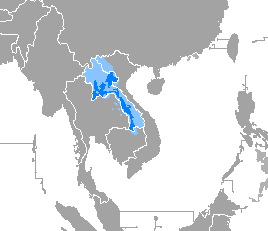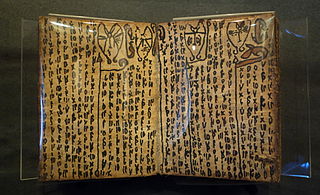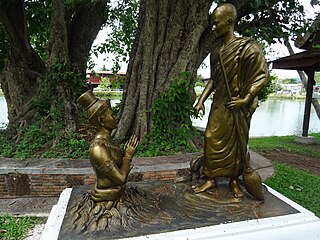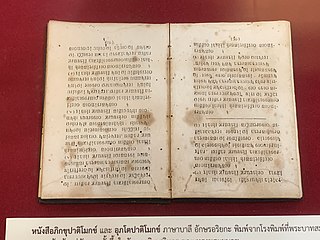Khmer(s) may refer to: The Khmer people (Khmer: ជនជាតិខ្មែរ, Chônchéatĕ Khmêr [cɔnciət kʰmae]) are an Austroasiatic ethnic group native to Cambodia. They comprise over 90% of Cambodia's population of 17 million.

Lao, sometimes referred to as Laotian, is a Kra–Dai language of the Lao people. It is spoken in Laos, where it is the official language for around 7 million people, as well as in northeast Thailand, where it is used by around 23 million people, usually referred to as Isan. Lao serves as a lingua franca among the citizens of Laos, who also speak approximately 90 other languages, many of which are unrelated to Lao.
Khmer script is an abugida (alphasyllabary) script used to write the Khmer language, the official language of Cambodia. It is also used to write Pali in the Buddhist liturgy of Cambodia and Thailand.

Tatchakorn Yeerum, better known internationally as Tony Jaa and in Thailand as Jaa Phanom, is a Thai martial artist, actor, action choreographer, stuntman, director, and traceur.

Cambodian New Year, also known as Choul Chnam Thmey and Moha Sangkranta or just Sangkranta, is the traditional celebration of the solar new year in Cambodia. A three-day public holiday in the country, the observance begins on New Year's Day, which usually falls on 13 April or 14 April, which is the end of the harvesting season, when farmers enjoy the fruits of their labor before the rainy season begins. Khmers living abroad may choose to celebrate during a weekend rather than just specifically 13 April through 16 April. The Khmer New Year coincides with the traditional solar new year in several parts of India, Bangladesh, Nepal, Sri Lanka, Myanmar, Laos and Thailand.
Ong Kommandam was the confidant and successor of Ong Keo as the leader of the Mon-Khmer tribes of southern Laos in their struggle for independence from French and Lao rule. Ong Keo was assassinated in 1910 by the Commissioner of Salavan, Jacques Dauplay. Kommandam survived the attack, which added to his status, and he united the highland minorities of Southern Laos. An ethnic Alak, he claimed that the "Khom" were indigenous to the area and previously held much more prestige and glory, first when the Khmer Empire ruled them, and later when they were a part of the Kingdom of Lan Xang. As part of his resistance activities, he invented a secret script to convey messages, the Khom script. He continued the fight for independence from 1910 until 1936 when he was killed.
Yantra tattooing or Sak Yant is a form of tattooing using Indian yantra designs. It consists of sacred geometrical, animal and deity designs accompanied by Pali phrases that are said to offer power, protection, fortune, charisma and other benefits for the bearer.
Khom is a Tai-language term referring to the people and civilization of the ancient Khmer Empire. Its use is recorded as early as the 13th century, though its exact meaning—whether it refers to a specific empire, a certain historical period, or the Khmer people in general—has been unclear throughout history. The term has been used extensively in 20th-century Thai history writing, partly as a way to disassociate the historical Angkorian civilization—of which many archaeological sites are spread throughout present-day Thailand—from the present-day Khmer people who form the majority population of Cambodia, whom many Thais still believe to be an inferior race unrelated to the people of the ancient empire. This discourse was popularized by 20th century Thai nationalist thinker Luang Wichitwathakan who asserted that contemporary Khmers are unrelated to the ethnic group responsible for the Angkorian civilization, coining the term "khom" for this purpose. By repurposing the term "khom" derived from the ancient Thai term "Khmer krom" meaning "lowland Khmer", Wichitwathakan attempted to create a new ethnicity to accentuate a distinct separation between Angkor and Cambodia, despite the ethnic continuity between Angkor's builders and present-day Khmer being well-established.

The Khom script is a writing system formerly used in Laos. The term "Khom" is also used to refer to the Ancient Khmer lettering used in Thailand's Buddhist temples to inscribe sacred Buddhist mantras and prayers, but that is an entirely different script.

Khatha, or "Gatha", as originally called in Pali Language), is the Khmer and Thai name used for Sacred Pali prayers, mantras and other magical incantations. Khatha are used in general by Thai people for a great many purposes; be it for protection, charm or business ventures, there is a Khatha which can be summoned. The word Khatha, or "Gatha" in Pali, means "Speech", and thus the original meaning of the word implies that Khatha were used only as spoken language, and not written form. In spite of this fact, the word Khatha is used to refer to both that which is spoken, and also written.

Musa 'Pisang Awak' is an edible banana cultivar belonging to the AABB banana cultivar group. This cultivar is grown worldwide.

Southeast Asia uses various non-Latin-based writing systems. The writing systems below are listed by language family.
Jru' is a Mon–Khmer language of the Bahnaric branch spoken in southern Laos. It is also known as "Loven", "Laven" or "Boloven" from the Laotian exonym Laven or Loven, which is derived from the Khmer name for the Boloven Plateau. The Jru' people engage in coffee and cardamom cultivation, as well as other agricultural activities.
Anti-Thai sentiment involves hostility or hatred that is directed towards people in Thailand, or the state of Thailand.
Anti-Khmer sentiment is a sentiment against Cambodia, the Khmers, overseas Khmer, or Khmer culture. As the Khmers are dominant in Cambodia, it can be attributed to anti-Cambodian sentiment and hatreds against Cambodians.

Phra Ruang is a legendary figure from Thai history, usually described as the founder of the first Thai kingdom who freed the people from the rule of the ancient Khmer Empire. It is also found as a title that may have referred to one or more kings of Sukhothai, and is referred to in the title of many works of literature, including the Trai Phum Phra Ruang, a Sukhothai-era religious text describing the Buddhist cosmology.

The Sukhothai script, also known as the proto-Thai script and Ram Khamhaeng alphabet, is a Brahmic script which originated in the Sukhothai Kingdom. The script is found on the Ram Khamhaeng Inscription and the Lö Thai inscription.

The Khom script is a Brahmic script and a variant of the Khmer script used in Thailand and Laos, which is used to write Pali, Sanskrit, Khmer and Thai.

The Ariyaka script is an obsolete alphabet, invented by King Mongkut as an alternative to transcribing Pali, the liturgical language of Theravada Buddhism. The script, inspired by the Greek and Burmese-Mon scripts, did not come into popular use and eventually fell out of usage.










